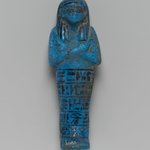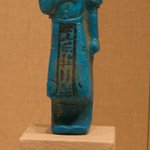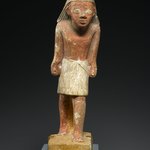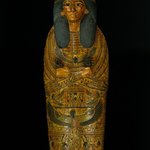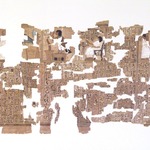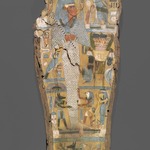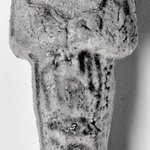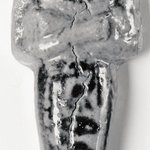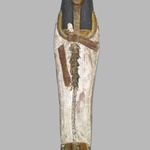

Outer Sarcophagus of the Royal Prince, Count of Thebes, Pa-seba-khai-en-ipet, ca. 1075–945 B.C.E. Wood (cedar and acacia), gesso, pigment, 37 x 30 1/4 x 83 3/8 in., 287 lb. (94 x 76.8 x 211.8 cm, 130.2kg). Brooklyn Museum, Charles Edwin Wilbour Fund, 08.480.1a-b. Creative Commons-BY (Photo: Brooklyn Museum, 08.480.1a-b_profile_PS1.jpg)

Outer Sarcophagus of the Royal Prince, Count of Thebes, Pa-seba-khai-en-ipet, ca. 1075–945 B.C.E. Wood (cedar and acacia), gesso, pigment, 37 x 30 1/4 x 83 3/8 in., 287 lb. (94 x 76.8 x 211.8 cm, 130.2kg). Brooklyn Museum, Charles Edwin Wilbour Fund, 08.480.1a-b. Creative Commons-BY (Photo: Brooklyn Museum, 08.480.1a-b_top_PS1.jpg)

Outer Sarcophagus of the Royal Prince, Count of Thebes, Pa-seba-khai-en-ipet, ca. 1075–945 B.C.E. Wood (cedar and acacia), gesso, pigment, 37 x 30 1/4 x 83 3/8 in., 287 lb. (94 x 76.8 x 211.8 cm, 130.2kg). Brooklyn Museum, Charles Edwin Wilbour Fund, 08.480.1a-b. Creative Commons-BY (Photo: Brooklyn Museum, 08.480.1a-b_detail_PS1.jpg)

Outer Sarcophagus of the Royal Prince, Count of Thebes, Pa-seba-khai-en-ipet, ca. 1075–945 B.C.E. Wood (cedar and acacia), gesso, pigment, 37 x 30 1/4 x 83 3/8 in., 287 lb. (94 x 76.8 x 211.8 cm, 130.2kg). Brooklyn Museum, Charles Edwin Wilbour Fund, 08.480.1a-b. Creative Commons-BY (Photo: Brooklyn Museum, CUR.08.480.1a-b.jpg)

Outer Sarcophagus of the Royal Prince, Count of Thebes, Pa-seba-khai-en-ipet, ca. 1075–945 B.C.E. Wood (cedar and acacia), gesso, pigment, 37 x 30 1/4 x 83 3/8 in., 287 lb. (94 x 76.8 x 211.8 cm, 130.2kg). Brooklyn Museum, Charles Edwin Wilbour Fund, 08.480.1a-b. Creative Commons-BY (Photo: Brooklyn Museum, CUR.08.480.1a-b_view2.jpg)

Outer Sarcophagus of the Royal Prince, Count of Thebes, Pa-seba-khai-en-ipet, ca. 1075–945 B.C.E. Wood (cedar and acacia), gesso, pigment, 37 x 30 1/4 x 83 3/8 in., 287 lb. (94 x 76.8 x 211.8 cm, 130.2kg). Brooklyn Museum, Charles Edwin Wilbour Fund, 08.480.1a-b. Creative Commons-BY (Photo: Brooklyn Museum, CUR.08.480.1a_detail_Thoth.jpg)
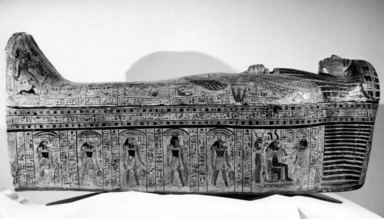
Outer Sarcophagus of the Royal Prince, Count of Thebes, Pa-seba-khai-en-ipet, ca. 1075–945 B.C.E. Wood (cedar and acacia), gesso, pigment, 37 x 30 1/4 x 83 3/8 in., 287 lb. (94 x 76.8 x 211.8 cm, 130.2kg). Brooklyn Museum, Charles Edwin Wilbour Fund, 08.480.1a-b. Creative Commons-BY (Photo: Brooklyn Museum, 08.480.1a_b_side_bw.jpg)

Outer Sarcophagus of the Royal Prince, Count of Thebes, Pa-seba-khai-en-ipet, ca. 1075–945 B.C.E. Wood (cedar and acacia), gesso, pigment, 37 x 30 1/4 x 83 3/8 in., 287 lb. (94 x 76.8 x 211.8 cm, 130.2kg). Brooklyn Museum, Charles Edwin Wilbour Fund, 08.480.1a-b. Creative Commons-BY (Photo: Brooklyn Museum, CUR.08.480.1a_detail1.jpg)
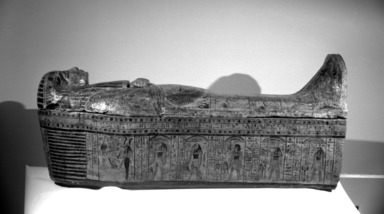
Outer Sarcophagus of the Royal Prince, Count of Thebes, Pa-seba-khai-en-ipet, ca. 1075–945 B.C.E. Wood (cedar and acacia), gesso, pigment, 37 x 30 1/4 x 83 3/8 in., 287 lb. (94 x 76.8 x 211.8 cm, 130.2kg). Brooklyn Museum, Charles Edwin Wilbour Fund, 08.480.1a-b. Creative Commons-BY (Photo: Brooklyn Museum, 08.480.1a-b_side_right_bw.jpg)

Outer Sarcophagus of the Royal Prince, Count of Thebes, Pa-seba-khai-en-ipet, ca. 1075–945 B.C.E. Wood (cedar and acacia), gesso, pigment, 37 x 30 1/4 x 83 3/8 in., 287 lb. (94 x 76.8 x 211.8 cm, 130.2kg). Brooklyn Museum, Charles Edwin Wilbour Fund, 08.480.1a-b. Creative Commons-BY (Photo: Brooklyn Museum, CUR.08.480.1a_detail2.jpg)

Outer Sarcophagus of the Royal Prince, Count of Thebes, Pa-seba-khai-en-ipet, ca. 1075–945 B.C.E. Wood (cedar and acacia), gesso, pigment, 37 x 30 1/4 x 83 3/8 in., 287 lb. (94 x 76.8 x 211.8 cm, 130.2kg). Brooklyn Museum, Charles Edwin Wilbour Fund, 08.480.1a-b. Creative Commons-BY (Photo: Brooklyn Museum, 08.480.1a-b_bottom_bw.jpg)

Outer Sarcophagus of the Royal Prince, Count of Thebes, Pa-seba-khai-en-ipet, ca. 1075–945 B.C.E. Wood (cedar and acacia), gesso, pigment, 37 x 30 1/4 x 83 3/8 in., 287 lb. (94 x 76.8 x 211.8 cm, 130.2kg). Brooklyn Museum, Charles Edwin Wilbour Fund, 08.480.1a-b. Creative Commons-BY (Photo: Brooklyn Museum, CUR.08.480.1a-b_negA_bw.jpg)

Outer Sarcophagus of the Royal Prince, Count of Thebes, Pa-seba-khai-en-ipet, ca. 1075–945 B.C.E. Wood (cedar and acacia), gesso, pigment, 37 x 30 1/4 x 83 3/8 in., 287 lb. (94 x 76.8 x 211.8 cm, 130.2kg). Brooklyn Museum, Charles Edwin Wilbour Fund, 08.480.1a-b. Creative Commons-BY (Photo: Brooklyn Museum, 08.480.1a-b_top_bw.jpg)

Outer Sarcophagus of the Royal Prince, Count of Thebes, Pa-seba-khai-en-ipet, ca. 1075–945 B.C.E. Wood (cedar and acacia), gesso, pigment, 37 x 30 1/4 x 83 3/8 in., 287 lb. (94 x 76.8 x 211.8 cm, 130.2kg). Brooklyn Museum, Charles Edwin Wilbour Fund, 08.480.1a-b. Creative Commons-BY (Photo: Brooklyn Museum, CUR.08.480.1a-b_negB_bw.jpg)

Outer Sarcophagus of the Royal Prince, Count of Thebes, Pa-seba-khai-en-ipet, ca. 1075–945 B.C.E. Wood (cedar and acacia), gesso, pigment, 37 x 30 1/4 x 83 3/8 in., 287 lb. (94 x 76.8 x 211.8 cm, 130.2kg). Brooklyn Museum, Charles Edwin Wilbour Fund, 08.480.1a-b. Creative Commons-BY (Photo: Brooklyn Museum, CUR.08.480.1a-b_negC_bw.jpg)

Outer Sarcophagus of the Royal Prince, Count of Thebes, Pa-seba-khai-en-ipet, ca. 1075–945 B.C.E. Wood (cedar and acacia), gesso, pigment, 37 x 30 1/4 x 83 3/8 in., 287 lb. (94 x 76.8 x 211.8 cm, 130.2kg). Brooklyn Museum, Charles Edwin Wilbour Fund, 08.480.1a-b. Creative Commons-BY (Photo: Brooklyn Museum, CUR.08.480.1a-b_negD_bw.jpg)

Outer Sarcophagus of the Royal Prince, Count of Thebes, Pa-seba-khai-en-ipet, ca. 1075–945 B.C.E. Wood (cedar and acacia), gesso, pigment, 37 x 30 1/4 x 83 3/8 in., 287 lb. (94 x 76.8 x 211.8 cm, 130.2kg). Brooklyn Museum, Charles Edwin Wilbour Fund, 08.480.1a-b. Creative Commons-BY (Photo: Brooklyn Museum, CUR.08.480.1a-b_negE_bw.jpg)

Outer Sarcophagus of the Royal Prince, Count of Thebes, Pa-seba-khai-en-ipet, ca. 1075–945 B.C.E. Wood (cedar and acacia), gesso, pigment, 37 x 30 1/4 x 83 3/8 in., 287 lb. (94 x 76.8 x 211.8 cm, 130.2kg). Brooklyn Museum, Charles Edwin Wilbour Fund, 08.480.1a-b. Creative Commons-BY (Photo: Brooklyn Museum, CUR.08.480.1a-b_negF_bw.jpg)

Outer Sarcophagus of the Royal Prince, Count of Thebes, Pa-seba-khai-en-ipet, ca. 1075–945 B.C.E. Wood (cedar and acacia), gesso, pigment, 37 x 30 1/4 x 83 3/8 in., 287 lb. (94 x 76.8 x 211.8 cm, 130.2kg). Brooklyn Museum, Charles Edwin Wilbour Fund, 08.480.1a-b. Creative Commons-BY (Photo: Brooklyn Museum, CUR.08.480.1a-b_negG_bw.jpg)

Outer Sarcophagus of the Royal Prince, Count of Thebes, Pa-seba-khai-en-ipet, ca. 1075–945 B.C.E. Wood (cedar and acacia), gesso, pigment, 37 x 30 1/4 x 83 3/8 in., 287 lb. (94 x 76.8 x 211.8 cm, 130.2kg). Brooklyn Museum, Charles Edwin Wilbour Fund, 08.480.1a-b. Creative Commons-BY (Photo: Brooklyn Museum, CUR.08.480.1a-b_negH_bw.jpg)

Outer Sarcophagus of the Royal Prince, Count of Thebes, Pa-seba-khai-en-ipet, ca. 1075–945 B.C.E. Wood (cedar and acacia), gesso, pigment, 37 x 30 1/4 x 83 3/8 in., 287 lb. (94 x 76.8 x 211.8 cm, 130.2kg). Brooklyn Museum, Charles Edwin Wilbour Fund, 08.480.1a-b. Creative Commons-BY (Photo: Brooklyn Museum, CUR.08.480.1a-b_negI_bw.jpg)

Outer Sarcophagus of the Royal Prince, Count of Thebes, Pa-seba-khai-en-ipet, ca. 1075–945 B.C.E. Wood (cedar and acacia), gesso, pigment, 37 x 30 1/4 x 83 3/8 in., 287 lb. (94 x 76.8 x 211.8 cm, 130.2kg). Brooklyn Museum, Charles Edwin Wilbour Fund, 08.480.1a-b. Creative Commons-BY (Photo: Brooklyn Museum, CUR.08.480.1a-b_negJ_bw.jpg)

Outer Sarcophagus of the Royal Prince, Count of Thebes, Pa-seba-khai-en-ipet, ca. 1075–945 B.C.E. Wood (cedar and acacia), gesso, pigment, 37 x 30 1/4 x 83 3/8 in., 287 lb. (94 x 76.8 x 211.8 cm, 130.2kg). Brooklyn Museum, Charles Edwin Wilbour Fund, 08.480.1a-b. Creative Commons-BY (Photo: Brooklyn Museum, CUR.08.480.1a-b_negK_bw.jpg)
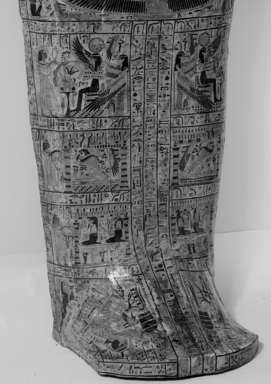
Outer Sarcophagus of the Royal Prince, Count of Thebes, Pa-seba-khai-en-ipet, ca. 1075–945 B.C.E. Wood (cedar and acacia), gesso, pigment, 37 x 30 1/4 x 83 3/8 in., 287 lb. (94 x 76.8 x 211.8 cm, 130.2kg). Brooklyn Museum, Charles Edwin Wilbour Fund, 08.480.1a-b. Creative Commons-BY (Photo: Brooklyn Museum, CUR.08.480.1a-b_negL_bw.jpg)

Outer Sarcophagus of the Royal Prince, Count of Thebes, Pa-seba-khai-en-ipet, ca. 1075–945 B.C.E. Wood (cedar and acacia), gesso, pigment, 37 x 30 1/4 x 83 3/8 in., 287 lb. (94 x 76.8 x 211.8 cm, 130.2kg). Brooklyn Museum, Charles Edwin Wilbour Fund, 08.480.1a-b. Creative Commons-BY (Photo: Brooklyn Museum, CUR.08.480.1a-b_negM_bw.jpg)

Outer Sarcophagus of the Royal Prince, Count of Thebes, Pa-seba-khai-en-ipet, ca. 1075–945 B.C.E. Wood (cedar and acacia), gesso, pigment, 37 x 30 1/4 x 83 3/8 in., 287 lb. (94 x 76.8 x 211.8 cm, 130.2kg). Brooklyn Museum, Charles Edwin Wilbour Fund, 08.480.1a-b. Creative Commons-BY (Photo: Brooklyn Museum, CUR.08.480.1a-b_negN_bw.jpg)

Outer Sarcophagus of the Royal Prince, Count of Thebes, Pa-seba-khai-en-ipet, ca. 1075–945 B.C.E. Wood (cedar and acacia), gesso, pigment, 37 x 30 1/4 x 83 3/8 in., 287 lb. (94 x 76.8 x 211.8 cm, 130.2kg). Brooklyn Museum, Charles Edwin Wilbour Fund, 08.480.1a-b. Creative Commons-BY (Photo: Brooklyn Museum, CUR.08.480.1a-b_negO_bw.jpg)

Outer Sarcophagus of the Royal Prince, Count of Thebes, Pa-seba-khai-en-ipet, ca. 1075–945 B.C.E. Wood (cedar and acacia), gesso, pigment, 37 x 30 1/4 x 83 3/8 in., 287 lb. (94 x 76.8 x 211.8 cm, 130.2kg). Brooklyn Museum, Charles Edwin Wilbour Fund, 08.480.1a-b. Creative Commons-BY (Photo: Brooklyn Museum, CUR.08.480.1a-b_negP_bw.jpg)

Outer Sarcophagus of the Royal Prince, Count of Thebes, Pa-seba-khai-en-ipet, ca. 1075–945 B.C.E. Wood (cedar and acacia), gesso, pigment, 37 x 30 1/4 x 83 3/8 in., 287 lb. (94 x 76.8 x 211.8 cm, 130.2kg). Brooklyn Museum, Charles Edwin Wilbour Fund, 08.480.1a-b. Creative Commons-BY (Photo: Brooklyn Museum, CUR.08.480.1a-b_negQ_bw.jpg)

Outer Sarcophagus of the Royal Prince, Count of Thebes, Pa-seba-khai-en-ipet, ca. 1075–945 B.C.E. Wood (cedar and acacia), gesso, pigment, 37 x 30 1/4 x 83 3/8 in., 287 lb. (94 x 76.8 x 211.8 cm, 130.2kg). Brooklyn Museum, Charles Edwin Wilbour Fund, 08.480.1a-b. Creative Commons-BY (Photo: Brooklyn Museum, CUR.08.480.1a-b_negR_bw.jpg)

Outer Sarcophagus of the Royal Prince, Count of Thebes, Pa-seba-khai-en-ipet, ca. 1075–945 B.C.E. Wood (cedar and acacia), gesso, pigment, 37 x 30 1/4 x 83 3/8 in., 287 lb. (94 x 76.8 x 211.8 cm, 130.2kg). Brooklyn Museum, Charles Edwin Wilbour Fund, 08.480.1a-b. Creative Commons-BY (Photo: Brooklyn Museum, CUR.08.480.1a-b_negS_bw.jpg)

Outer Sarcophagus of the Royal Prince, Count of Thebes, Pa-seba-khai-en-ipet, ca. 1075–945 B.C.E. Wood (cedar and acacia), gesso, pigment, 37 x 30 1/4 x 83 3/8 in., 287 lb. (94 x 76.8 x 211.8 cm, 130.2kg). Brooklyn Museum, Charles Edwin Wilbour Fund, 08.480.1a-b. Creative Commons-BY (Photo: Brooklyn Museum, CUR.08.480.1a-b_negT_bw.jpg)
Outer Sarcophagus of the Royal Prince, Count of Thebes, Pa-seba-khai-en-ipet
Egyptian, Classical, Ancient Near Eastern Art
On View: Funerary Gallery 1, Martha A. and Robert S. Rubin Gallery, 3rd Floor
The damage to the painted surface on the left side of the coffin has been left unrepaired to reveal how the carpenters pinned smaller pieces of wood together with wooden pegs to make a coffin. Artists then plastered and painted the surface to make it appear smooth.











